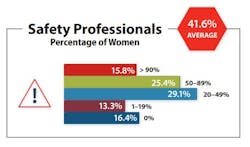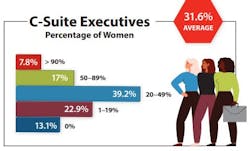WIT: Women in driver, technician roles still low, but their numbers gain elsewhere
Women still make up low percentages in two high-profile roles in trucking and transportation—drivers and technicians—but are making inroads in both occupations and form much higher percentages of the workforce in other key departments at commercial fleets and related organizations such as dispatch, safety, HR, and importantly the C-suite and boards of directors, according to brand-new data from the Women In Trucking Association 2023 Index, released July 10.
The 2023 breakdown of 350 respondents—collected from January through April this year from for-hire and private fleets and at third-party logistics providers, truck brokers, intermodal marketing companies and manufacturers, retailers, and distributors—revealed that 12.1% of professional truck drivers are women, a 1.6% drop from WIT’s 2022 index, though there has been a significant increase in the number of female CDL-holders over the last five years.
WIT reported that the percentage of women drivers is down in 2023 because of several intervening factors: a lack of quality child care, an increased interest in the homeschooling of children, safety concerns for female drivers, misperceptions of career opportunities for them, and an aging driver population that is now retiring.
See also: Women in Transportation 2023
“While some motor carriers and asset-based 3PLs saw the COVID pandemic have a negative impact on recruiting and retention of female professional drivers, others found that women continue to see a career as a professional truck driver to be a good fit for them,” WIT notes in a summary of the survey results.
“This is why the WIT Index is so important to the industry,” she added in a release on the 2023 results from the organization of 8,000 members in more than 10 nations. “Given the mission of the Women In Trucking Association in part is to encourage the employment of women in the trucking industry, we need to keep monitoring the progress made in bringing more women to all roles in transportation, and continuously look for ways to help our member companies and the industry at-large to recruit and retain talented women in critical roles.”
See also: Women in Transportation 2022: Trailblazers in trucking
In an interview with FleetOwner, Hedrick added: "We continue to see significant effort on the part of for-hire fleets, asset-based 3PLs, and private fleets to attract and retain professional drivers into the field. These companies see the value in hiring qualified employees who can do the job, and there’s no question that many females are well-suited for careers behind the wheel, as they possess many of the characteristics required to be a professional driver. They’re talented, skilled communicators, organized, patient, and able to multi-task.”
The U.S. Bureau of Labor Statistics already identifies commercial vehicle technicians as a high-demand profession with significant shortages. The WIT index has split results on this slice of the trucking and transportation workforce for women: Just 7.5% of technicians are female—but that’s a 3.8% increase from the same survey in 2022. Of the 350 respondent companies, 46.6% reported they had no women in technician roles. And only 24% reported that between 1% and 4% of their overall technicians are women.
See also: Gaskins: We can solve the technician shortage
“We’re excited to see that the percentage of diesel technicians has risen significantly compared to last year, given this profession is not typically a traditional one that women consider,” Hedrick told FleetOwner.
Higher numbers of women in critical office roles
According to the 2023 WIT index, women occupied other roles in trucking and transportation—dispatch, safety, and HR, for example—at a much higher percentages than behind the wheel or in vehicle maintenance and repair shops.
Also in the 2023 WIT survey, nearly 40% participating organizations reported more than 90% of professionals in HR and talent management are female, and another 48.6% said that between 50% and 89% in those roles are women.
See also: ATA establishes Women in Motion Mentorship Program
"Why are women typically more skilled in HR?" the WIT report asks. "In general, women tend to have a better Emotional Intelligence (EI) score than men. Such qualities reflected in the EI score include multitasking, leadership, planning, communication, and solid human relations skills and ultimately give women a professional advantage in the HR field."
In trucking and transportation, 43.5% of all dispatchers are women, according to the WIT survey. Nearly 30% of respondents reported that 20% to 49% of their dispatchers are women. Another 30.6% said between 50% and 89% of their dispatchers are female, while another 11.4% reported more than 90% female dispatchers. Slightly over 33% have less than 19% dispatchers who are women.
And 41.6% of all safety professionals at for-hire and private fleets are women, the 2023 index shows. A significant percentage (29.1%) report that they have women in 20% to 49% of their overall safety positions. Another 25.4% report they have women in 50% to 89% of these critical roles. Nearly 16% indicate they have 90% or more of their safety roles filled by females. About 29.7% of respondents say they have less than 20% of safety positions filled by women.
Progress in the C-suite, boards of directors
And women are making significant progress in the C-Suite and on boards of directors, this year's WIT survey showed.
See also: Five Good Things: Top women to watch in transportation
As far as company leaders in the transportation industry, the 2023 WIT index defines “company leaders” as people with supervisory responsibilities and also includes C-suite executives, and respondents reported 36.9% of company leaders with supervisory responsibilities are women.
About 45.6% of respondents reported between 20% and 49% of company leaders are women while another 25.1% said between 50% and 89% of these leaders are female. About 22% said 1% to 19% of company leaders are women.
Companies participating in this year’s WIT Index reported 28.4% of members of their boards of directors are women. Of those companies, 39.4% said 20% to 49% of their boards were made up of females while 16.3% report that have between 1% and 19% of their boards are women, and another 13.7% said that between 50% and 89% of their boards are made up of females. Nearly a quarter (23.1%) said they have no female representation on their boards.
Diversity and inclusion policies more prevalent
Last year was just the first time that the WIT index asked respondents to report on whether they had formal diversity and inclusion policies. In 2022, a large percentage, 45.5%, confirmed that they did, while 31% reported they didn't, and 18% said their company was in the process of developing them.
This year, trucking and transportation companies reported even more progress on phasing in these policies. Of those, 56.4% confirmed they have diversity and inclusion policies in place, a 10.9% increase over 2022. Another 19.3% reported they do not have formal D&I policies (down 11.7% from last year) while 19.3% said they are in the process of developing them, according to WIT.
See also: Women speak up about harassment in trucking
“I have been in the transportation industry for over 31 years. When I first started, there were very few women in the industry, let alone any key roles,” said Lisa Gonnerman, a voice for women in trucking and a safety and security stakeholder as president of refrigerated trucking for Bay & Bay Transportation.
“It was not always easy being a women in a male-dominated industry—in fact it was quite difficult. It is great to see more women in all areas of trucking, from drivers, to mechanics, to office staff, and management. Times have changed and there is more acceptance all around for these roles to be filled by women. We need to continue to remove barriers in all areas to encourage a diverse representation of all areas of diversity.”
About the overall results of the 2023 survey, WIT's Hedrick told FleetOwner: “Frankly, there are no significant surprises this year, as we continue to make good strides in bringing more women into the trucking industry. But what’s promising is when you compare the long-term progress we’ve made in last several years, things are happening. Meaningful conversations are being had about the skill sets and value that women bring to the table. We still have progress to make, but it’s happening!”
About the Author
Scott Achelpohl
Managing Editor
Scott Achelpohl is a former FleetOwner managing editor who wrote for the publication from 2021 to 2023. Since 2023, he has served as managing editor of Endeavor Business Media's Smart Industry, a FleetOwner affiliate.




